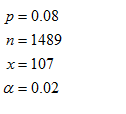Has that rate of genetic testing changed in recent years in the U.S.? In a 2016 Harvard Poll of 1,489 randomly selected U.S. adults, 107 said that they had personally had some type of genetic testing done. Use the steps below and a significance (alpha) level of 0.02 to lest the hypothesis that the population proportion of U.S. adults who have had genetic testing done was different in 2016 than it is today. Let's pretend that we have evidence that the population proportion today is 8%. * For this scenario, what would be the null hypothesis? * For this scenario, what would be the alternative hypotheses? (Note: the word
"hypothesis" is singular, and the plural of that word is "hypotheses.")
Has that rate of genetic testing changed in recent years in the U.S.? In a 2016 Harvard Poll of 1,489 randomly selected U.S. adults, 107 said that they had personally had some type of genetic testing done. Use the steps below and a significance (alpha) level of 0.02 to lest the hypothesis that the population proportion of U.S. adults who have had genetic testing done was different in 2016 than it is today. Let's pretend that we have evidence that the population proportion today is 8%. * For this scenario, what would be the null hypothesis? * For this scenario, what would be the alternative hypotheses? (Note: the word "hypothesis" is singular, and the plural of that word is "hypotheses.")
MATLAB: An Introduction with Applications
6th Edition
ISBN:9781119256830
Author:Amos Gilat
Publisher:Amos Gilat
Chapter1: Starting With Matlab
Section: Chapter Questions
Problem 1P
Related questions
Question
Has that rate of genetic testing changed in recent years in the U.S.? In a 2016 Harvard Poll of 1,489 randomly selected U.S. adults, 107 said that they had personally had some type of genetic testing done. Use the steps below and a significance (alpha) level of 0.02 to lest the hypothesis that the population proportion of U.S. adults who have had genetic testing done was different in 2016 than it is today. Let's pretend that we have evidence that the population proportion today is 8%.
* For this scenario, what would be the null hypothesis?
* For this scenario, what would be the alternative hypotheses? (Note: the word
"hypothesis" is singular, and the plural of that word is "hypotheses.")
Expert Solution
Step 1: Determine the claim
The claim is defined below as follows:
From the given information, the claim is to test if the population proportion today is 8% or not.

Step by step
Solved in 6 steps with 9 images

Recommended textbooks for you

MATLAB: An Introduction with Applications
Statistics
ISBN:
9781119256830
Author:
Amos Gilat
Publisher:
John Wiley & Sons Inc

Probability and Statistics for Engineering and th…
Statistics
ISBN:
9781305251809
Author:
Jay L. Devore
Publisher:
Cengage Learning

Statistics for The Behavioral Sciences (MindTap C…
Statistics
ISBN:
9781305504912
Author:
Frederick J Gravetter, Larry B. Wallnau
Publisher:
Cengage Learning

MATLAB: An Introduction with Applications
Statistics
ISBN:
9781119256830
Author:
Amos Gilat
Publisher:
John Wiley & Sons Inc

Probability and Statistics for Engineering and th…
Statistics
ISBN:
9781305251809
Author:
Jay L. Devore
Publisher:
Cengage Learning

Statistics for The Behavioral Sciences (MindTap C…
Statistics
ISBN:
9781305504912
Author:
Frederick J Gravetter, Larry B. Wallnau
Publisher:
Cengage Learning

Elementary Statistics: Picturing the World (7th E…
Statistics
ISBN:
9780134683416
Author:
Ron Larson, Betsy Farber
Publisher:
PEARSON

The Basic Practice of Statistics
Statistics
ISBN:
9781319042578
Author:
David S. Moore, William I. Notz, Michael A. Fligner
Publisher:
W. H. Freeman

Introduction to the Practice of Statistics
Statistics
ISBN:
9781319013387
Author:
David S. Moore, George P. McCabe, Bruce A. Craig
Publisher:
W. H. Freeman